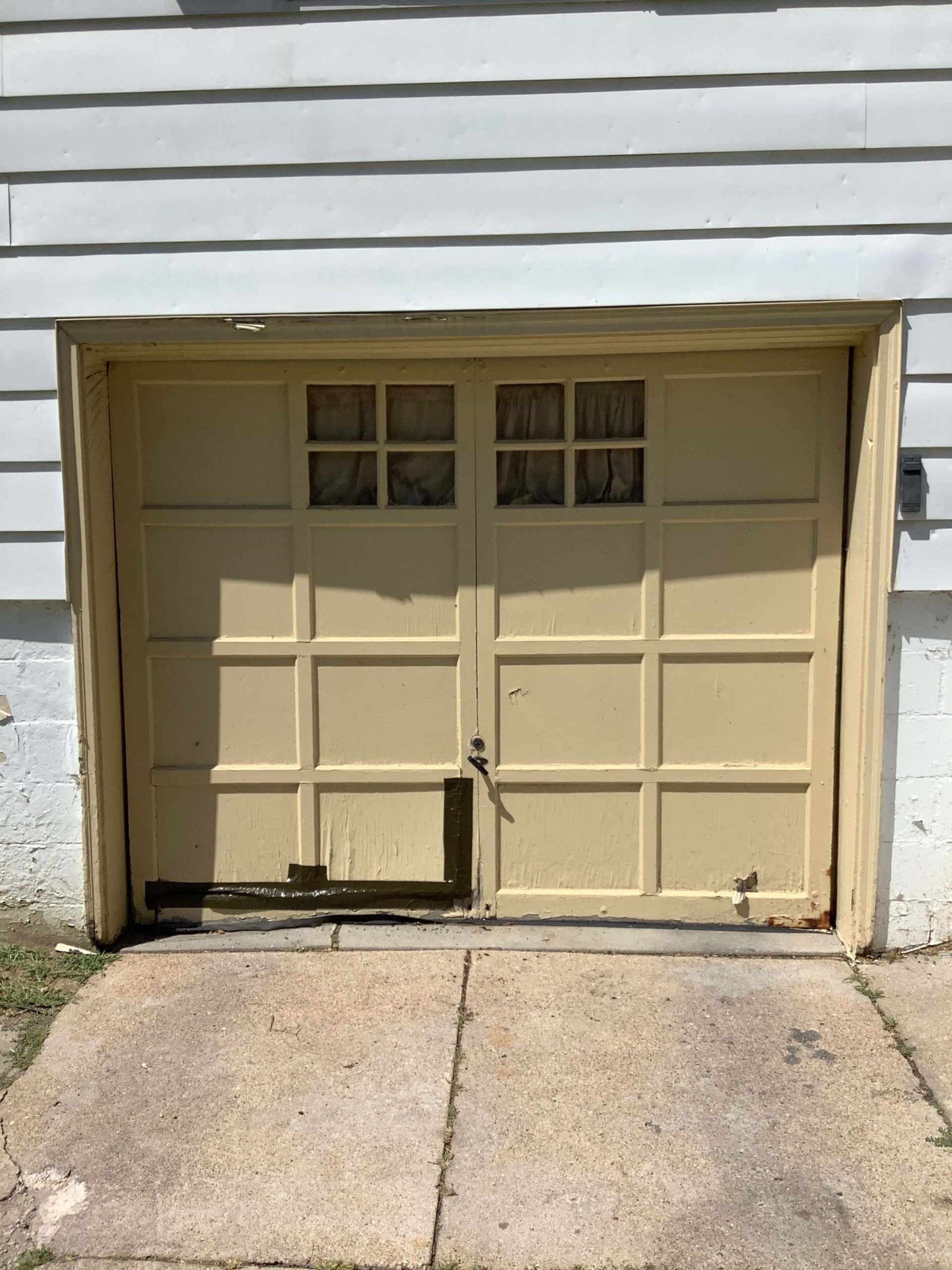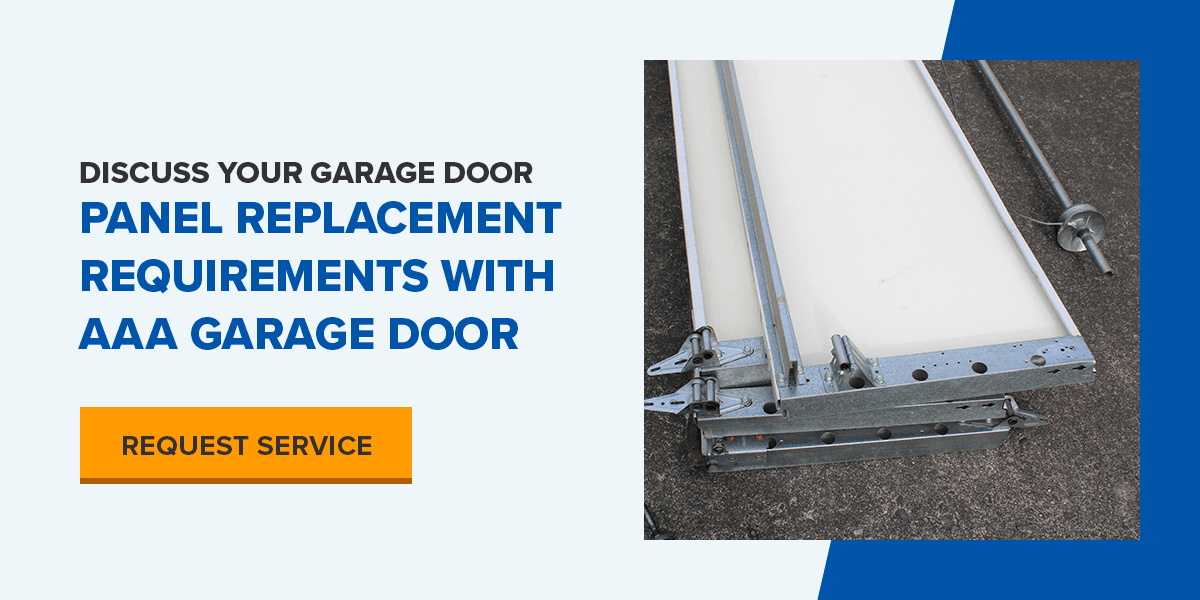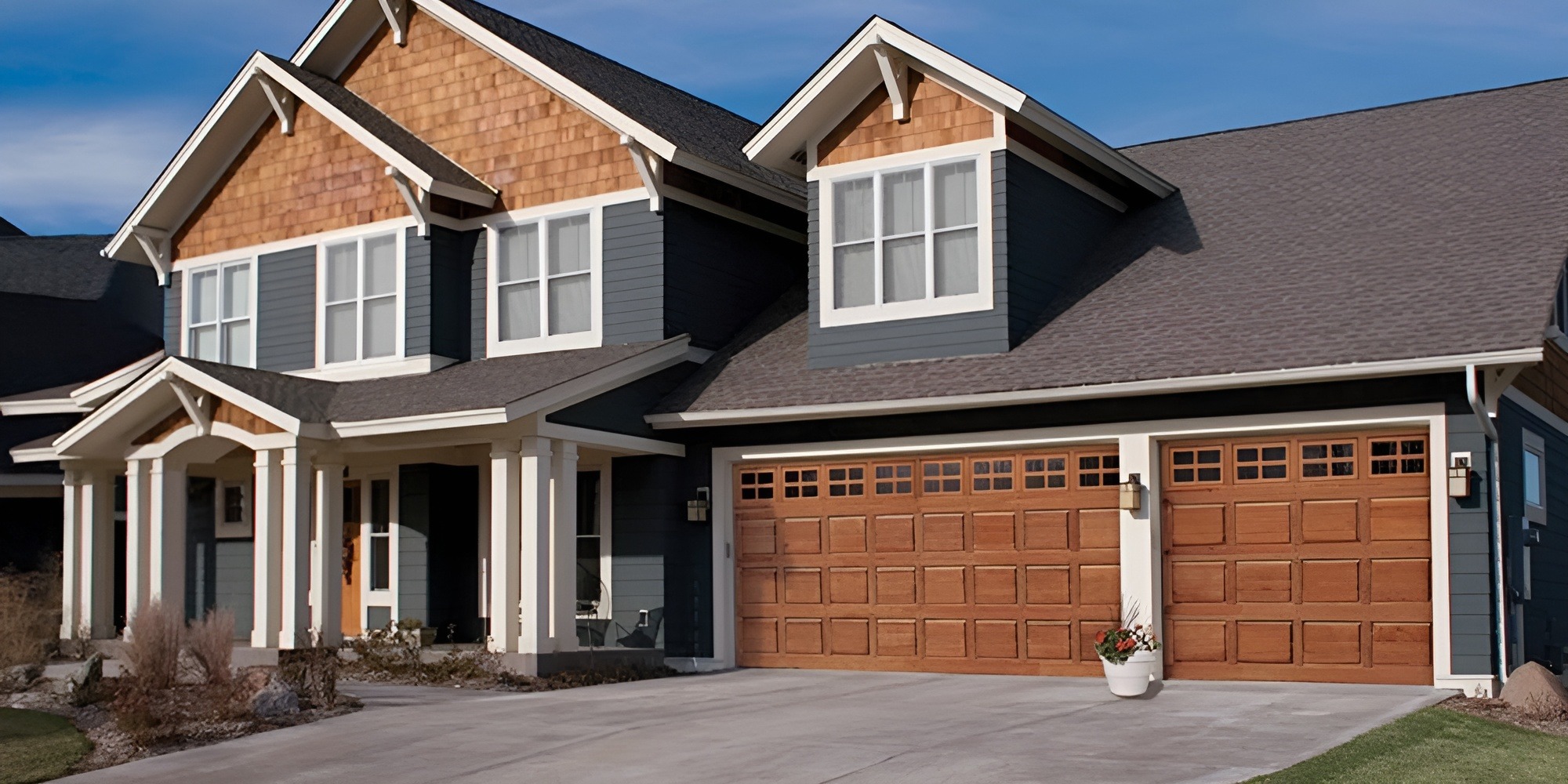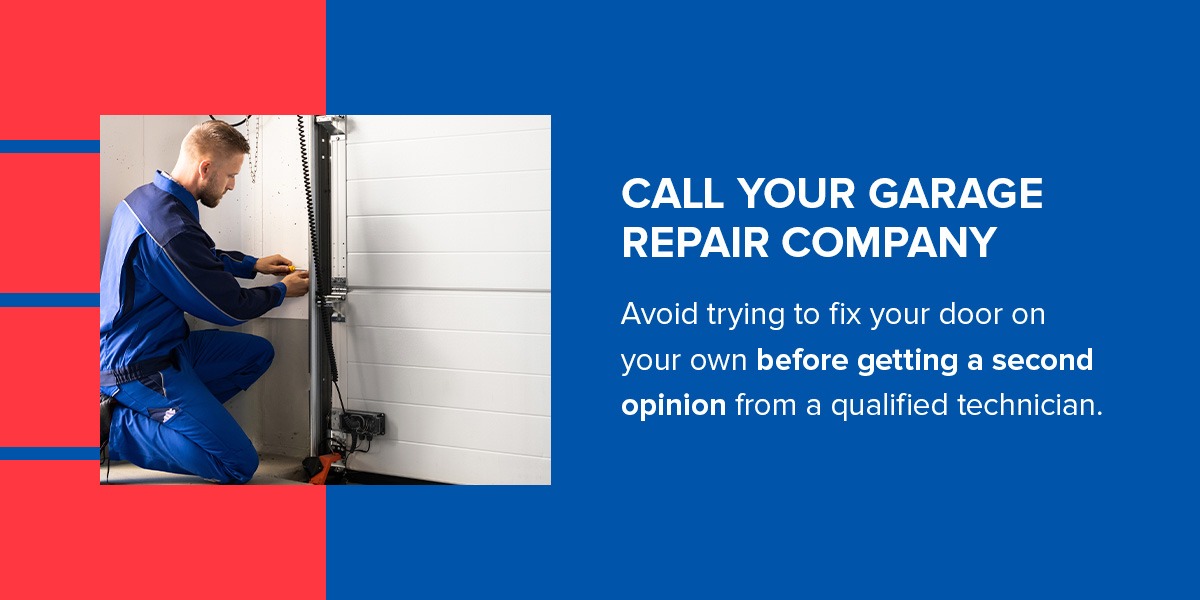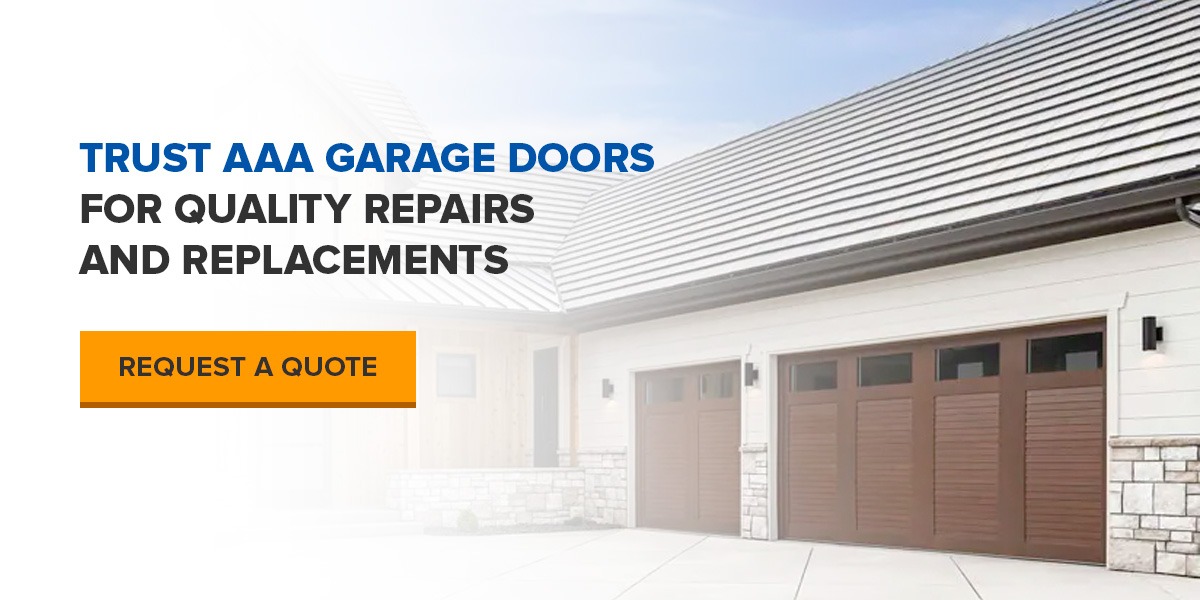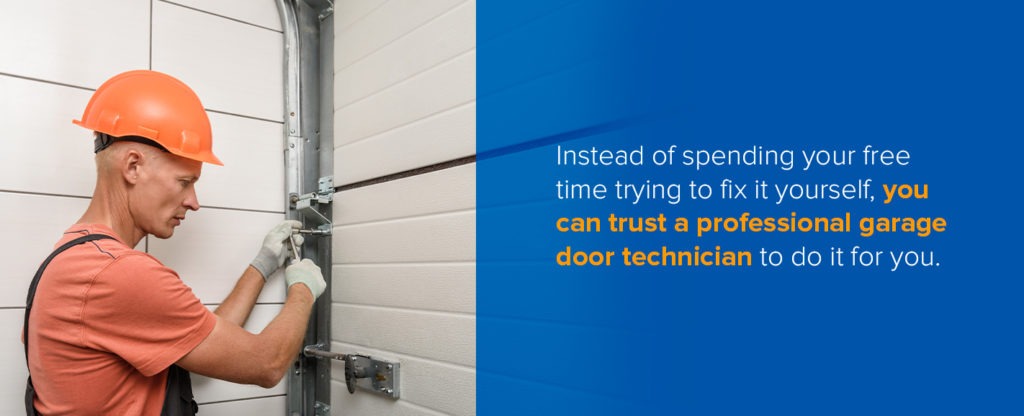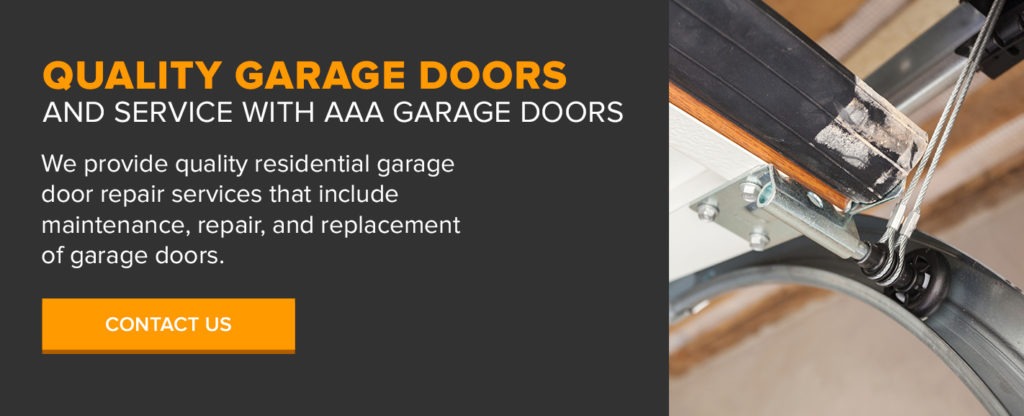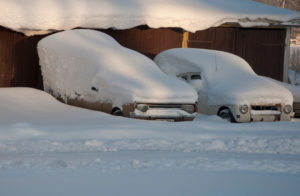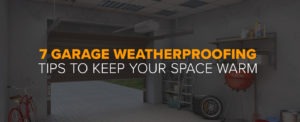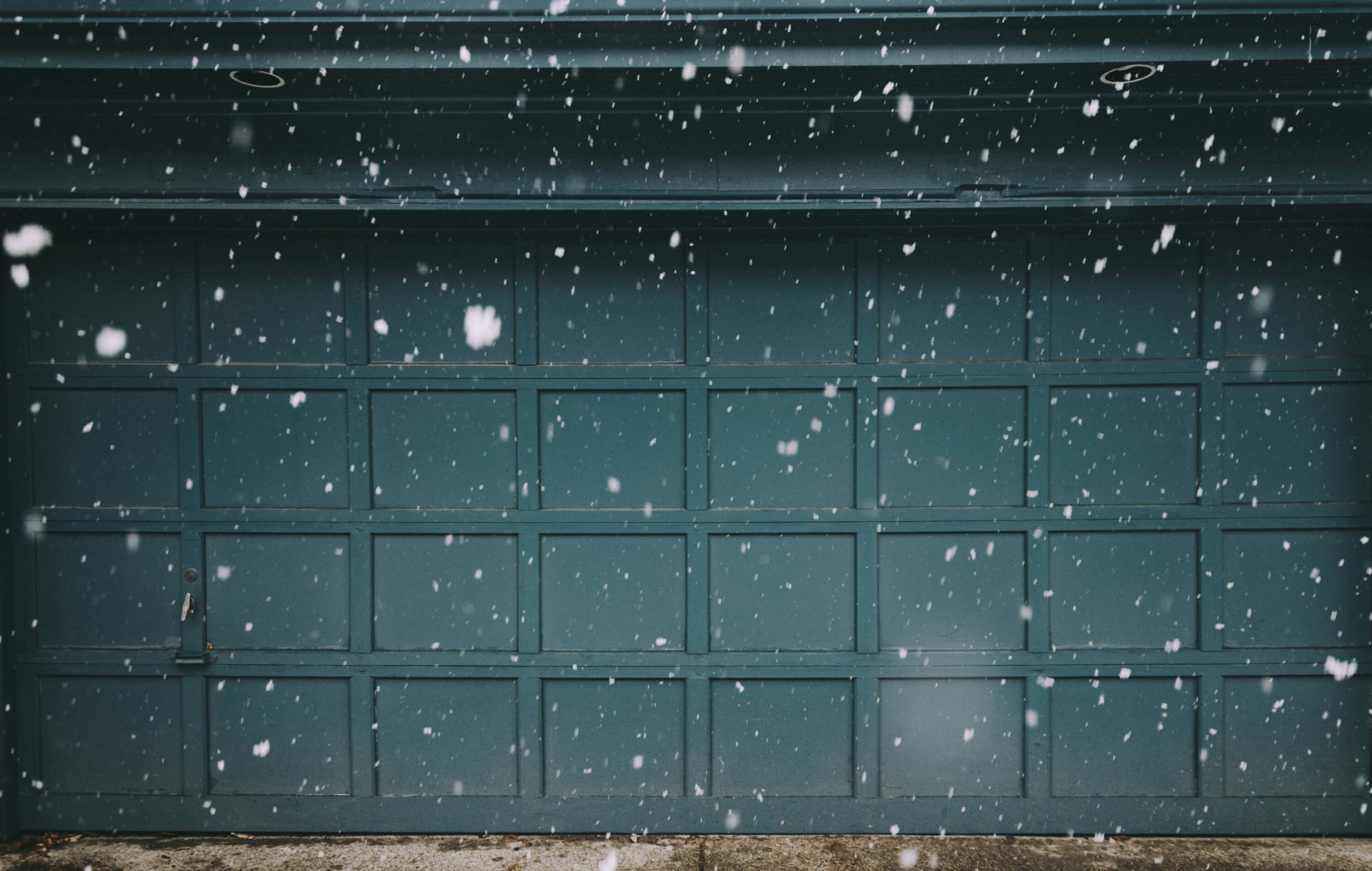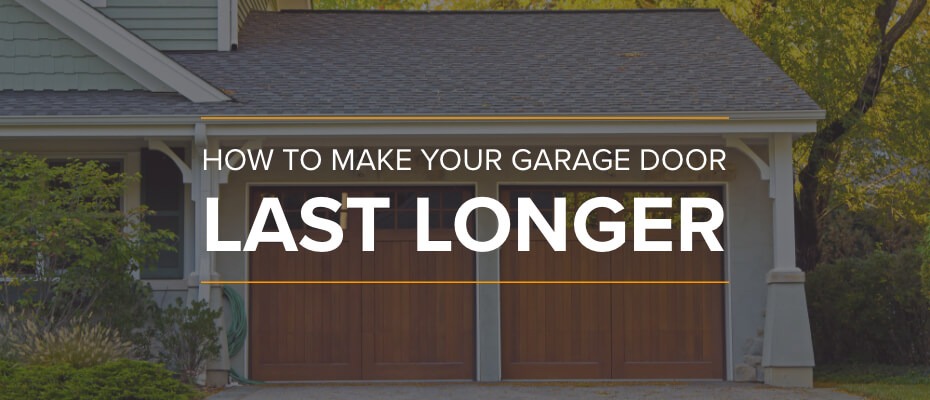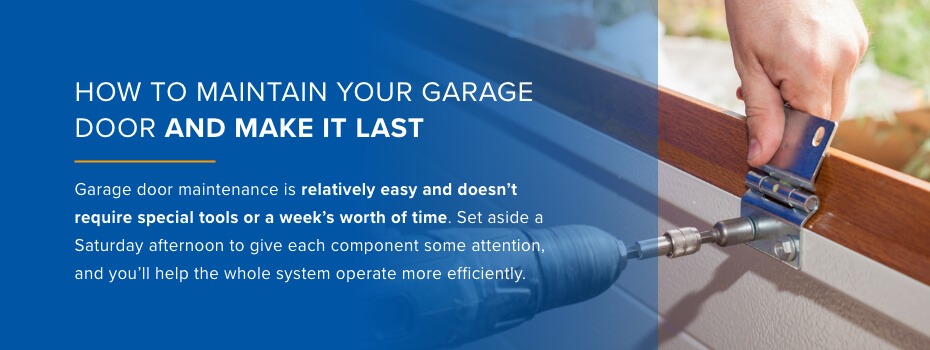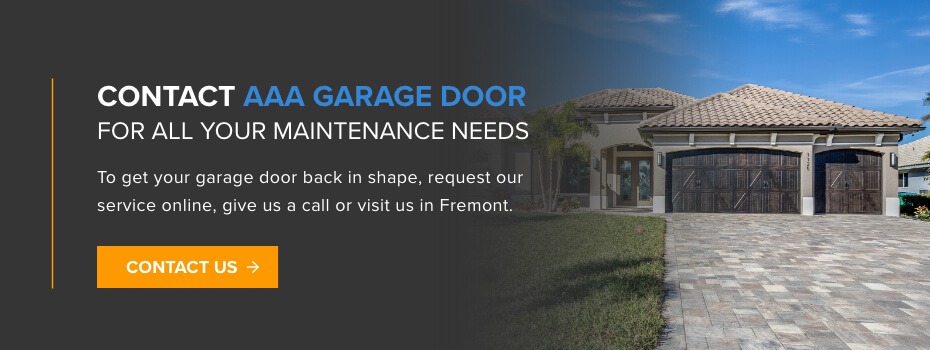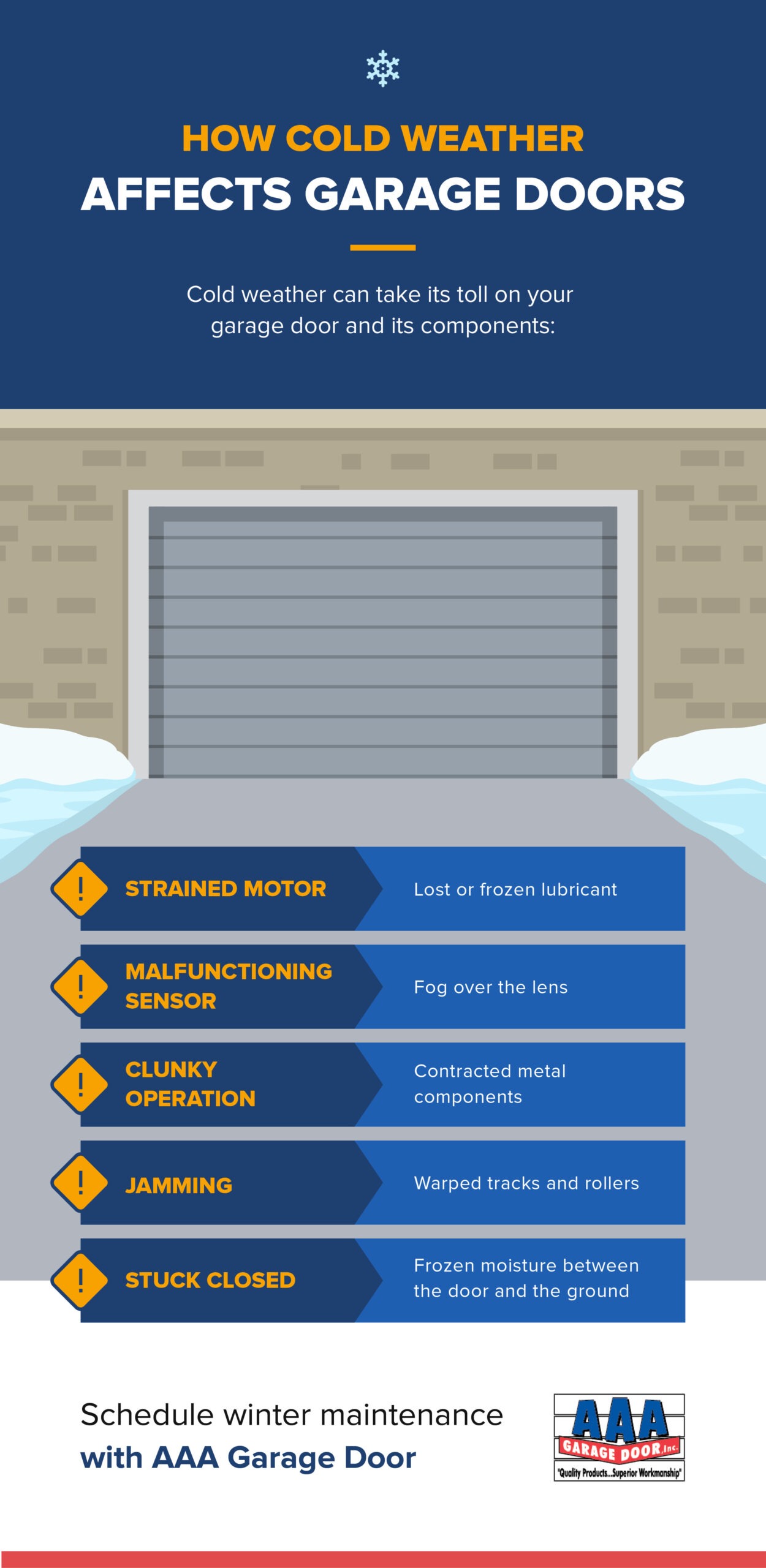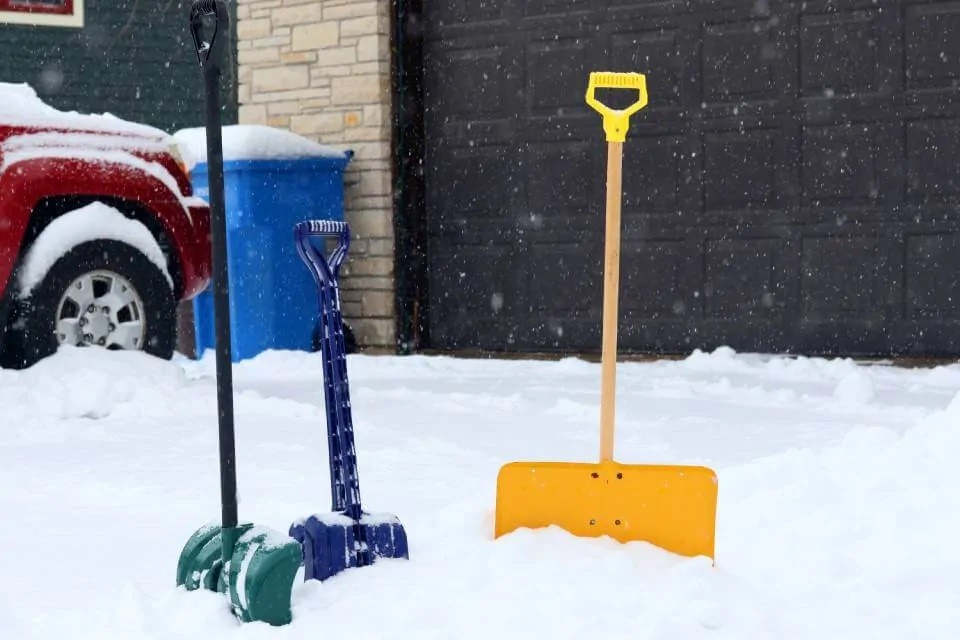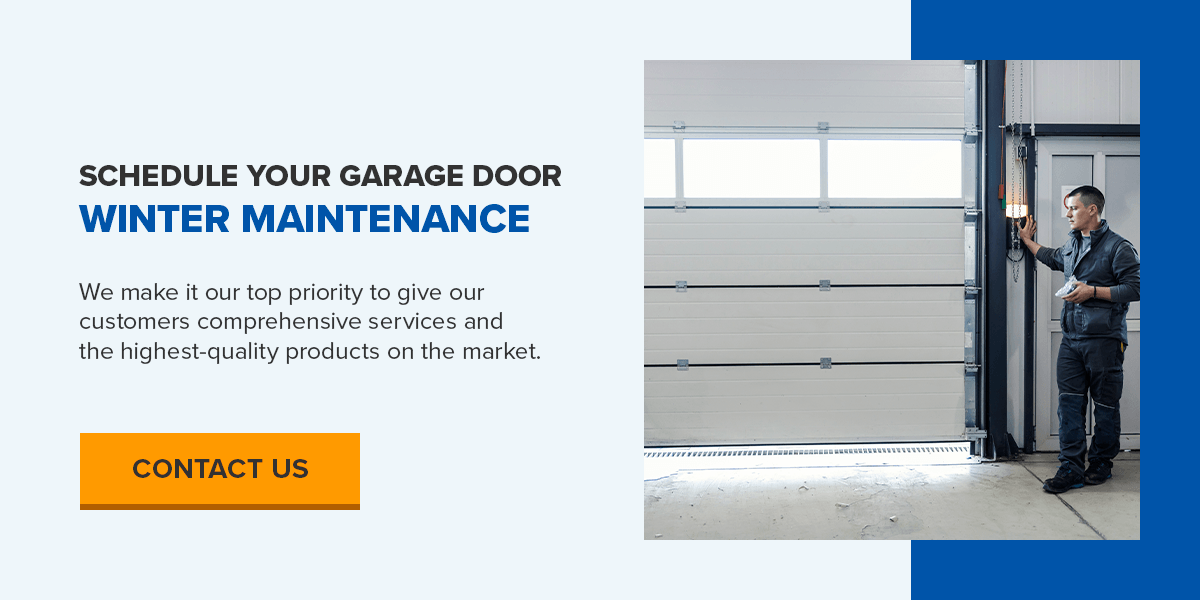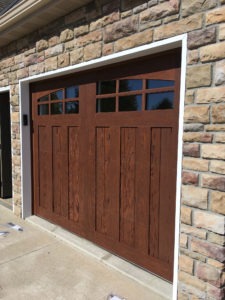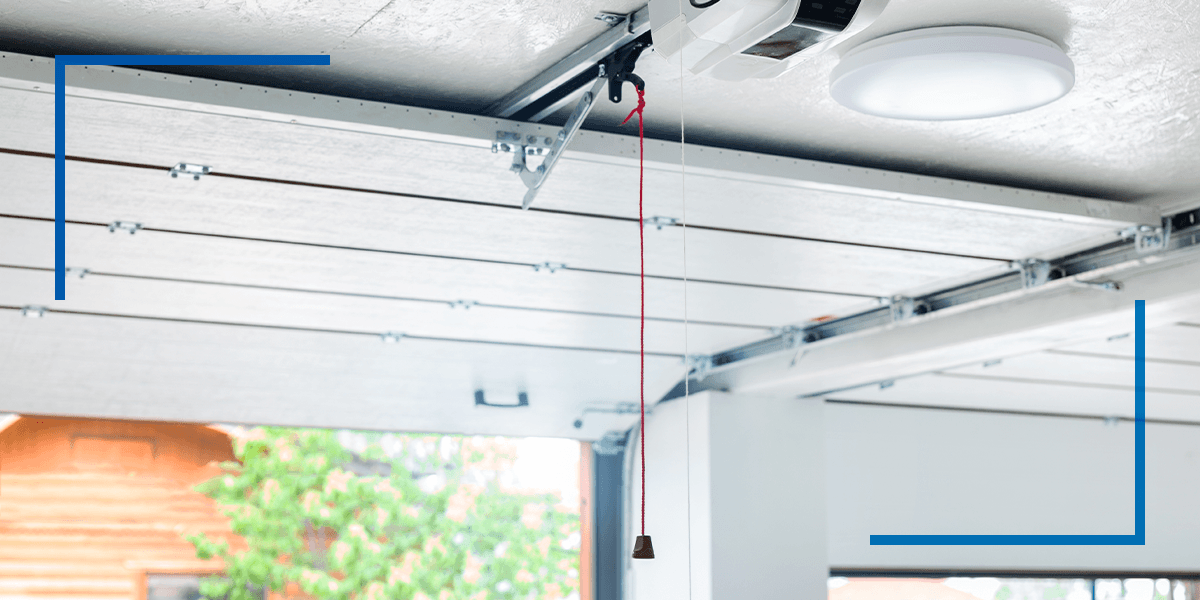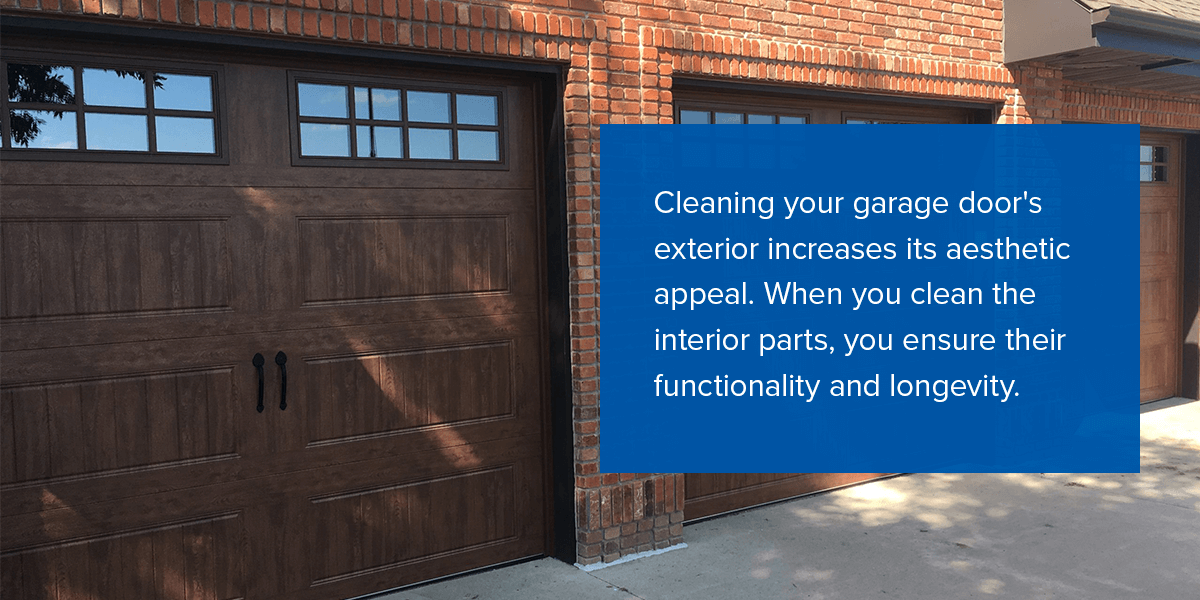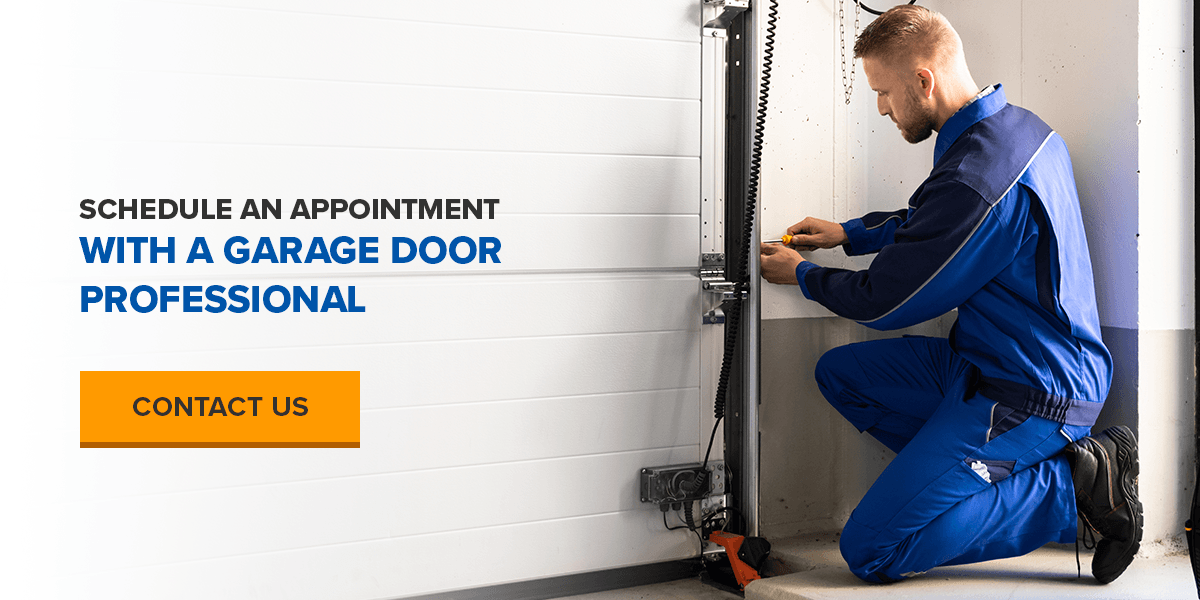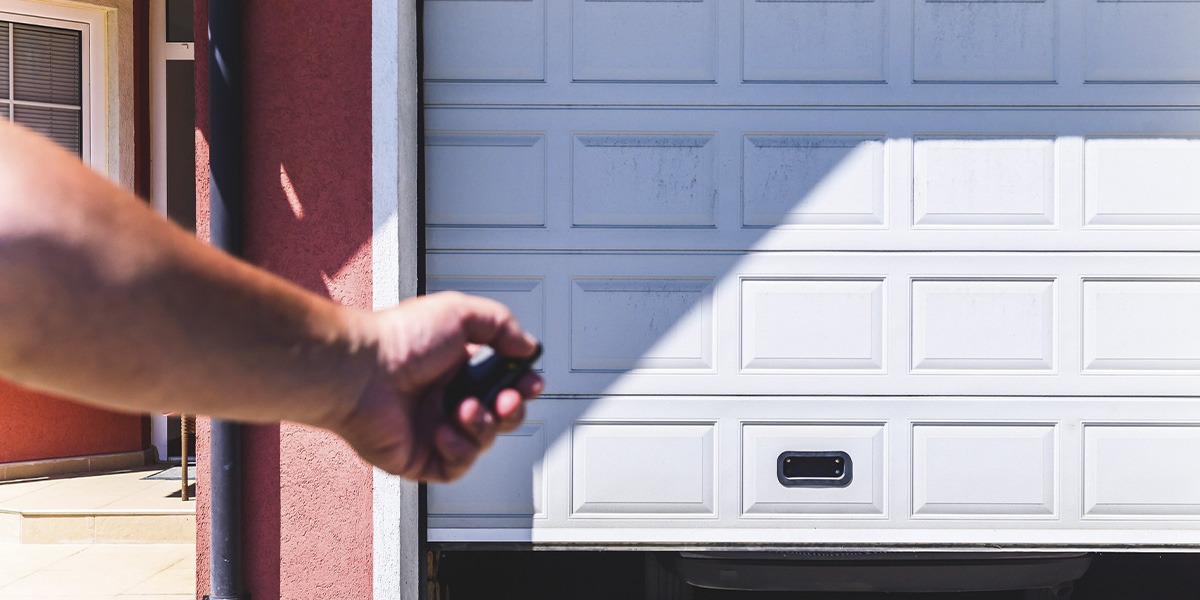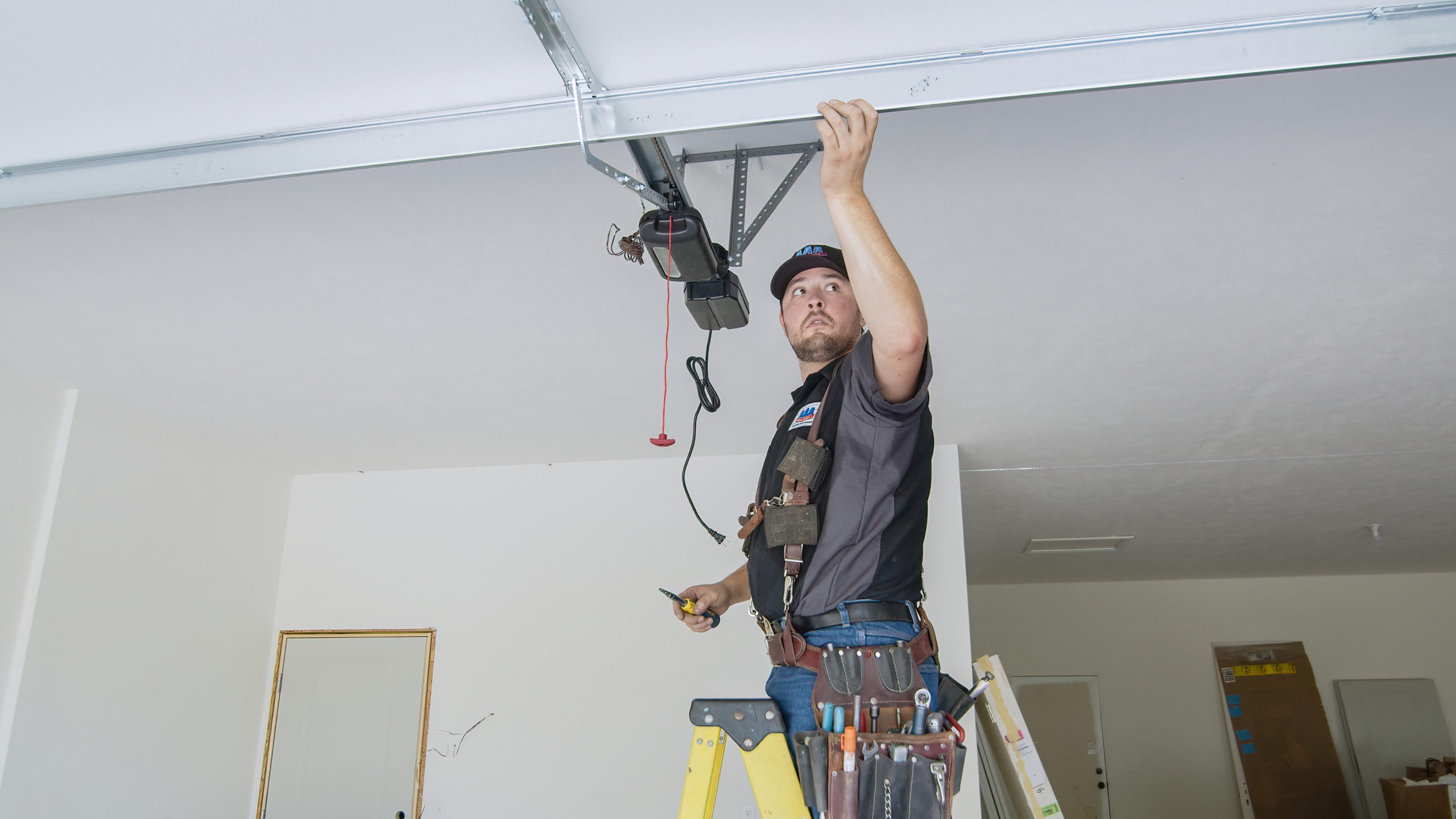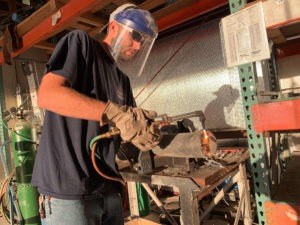Broken Garage Door Panels: Should You Replace 1 or All?
Broken Garage Door Panels: Should You Replace 1 or All?
Deciding whether to replace or repair the garage depends on a lot of factors but the easiest way to tell is by how badly the door is damaged.
If only a couple of panels have been damaged it will probably be more cost-effective to replace the garage door panels than the entire door. Here are a couple of other things to consider when deciding between the two options.
The Door’s Age
With proper maintenance and care, garage doors can last between 20 and 30 years. If your door is reaching its end of life, it might be best to replace the entire garage door. Newer doors that are 10 years old or less can be suitable for garage door panel replacements, but it might be difficult to find your door panel’s exact color, model and material.
The Extent and Type of Damage
Sometimes, the extent of damage to your garage door warrants a complete door replacement. For example, strong winds can cause large objects to hit the door, causing irreparable damage. In this case, the best option would be to replace the entire garage door.
If the damage is minor and only on one or two panels, replacing only those panels will likely be sufficient to get your garage door looking great again. However, it is still a good idea to have a professional inspect the rest of the door for damage to ensure the door’s structural integrity isn’t compromised.
The Door’s Layout and Design
If you’re thinking about replacing one or more panels, consider your door’s layout and design. Depending on your garage door’s age, its design may be obsolete. Using panels that don’t quite match your door could make them look out of place rather than blending in naturally with the rest of the panels.
Can I Replace the Garage Door Panels Only?
You can replace individual or multiple panels instead of the complete door, but the door should be well maintained to consider replacement. For example, an old, worn door may show signs of deterioration, such as peeling and flaking. You could replace the affected panels, but you will likely notice a style and color mismatch as the new panels stand out from the old ones.
Risks of Replacing Individual Garage Door Panels
Replacing individual garage door panels instead of the entire door has a few inherent risks to consider.
Internal Damage
You may not see it, but your garage door could have internal damage that impacts other components, such as the springs, rails or hinges. These components hold the garage door in place and contribute to its sturdiness. Replacing one panel won’t fix the internal damage. At the very least, the other components should also be repaired or replaced. The best solution, though, might be an entirely new garage door.
Functionality
Replacing a single panel might impact the door’s functionality. For example, even if just one panel is dented, the entire door must be checked to make sure it is still straight and properly aligned on the tracks. If the panel is replaced, but the door isn’t straight, the issue is not entirely solved.
Aesthetics
A newly replaced individual panel can be noticeable among older panels, detracting from your home’s curb appeal. Design limitations may also prevent you from replacing individual or multiple panels, leaving you with two options — replacing all the panels or the entire garage door.
How Much Does Replacing Garage Door Panels Cost?
A single garage door panel replacement can range from $200-$700 depending on the model. Like everything in life, the cost of replacing versus repairing a damaged panel is going to be a significant consideration. Repairing the panel is almost always the more affordable option, and with the help of our team at AAA Garage Doors, your repaired panel can often look as good as new. On the other hand, if your garage door is past its prime and the panels are damaged, then it might just make more financial sense to replace the entire garage door.
Although in the long run, getting your garage door panels replaced might save you money because you won’t be paying maintenance costs as often. With a new Omaha garage door, you will have to call our repair technicians at AAA Garage Doors less often, your home will be kept more secure, and you can enjoy some of the mod-cons that many newer garage doors now come with, such as energy efficiency options, smart technology, and sensors.
Can I Replace Garage Door Panels On My Own?
It’s possible to replace your garage door panels yourself, but we advise against it for several reasons. It’s a complex process that requires special tools and expertise. The door’s weight is another factor, and incorrectly handling it can cause damage to the door and its components. You risk injuring yourself, too.
We recommend contacting a professional garage door contractor to replace the panels for the best results.
How to Match Your Garage Door Panel When Replacing/Repairing
- The first thing you’ll want to do is tell your garage door repair company who the manufacturer of the garage door is and they’ll be able to contact them to see if they have any spare parts. It might be possible to get a matching piece to your garage door.
- You could re-paint the garage door panel that doesn’t match the rest of your garage. There are paints specifically made for exterior doors. Make sure to ask your garage door technician which type of paint is best for your garage door material.
Discuss Your Garage Door Panel Replacement Requirements With AAA Garage Door
Before attempting to replace your garage door panels, speak to our experts at AAA Garage Door for advice on a suitable option. Replacing individual garage door panels works well in many situations, but in some instances, replacing the entire door may be better. We’ll consider various factors to put your mind at ease and find a solution that suits your situation and budget. Call us at 402-307-8013 or request our services online today.
Learn About Garage Door Panel Replacement
Ran Into Your Garage Door? Here’s How to Fix It
As a homeowner, you have much to think about and often little time to get through everything. It can be easy to get caught up in your to-do lists, phone calls and planning, so much so that you reverse out of your home and accidentally back into your garage door while it’s still opening.
Now you’re either at a standstill or panicking, processing what happened and what to do next. While this situation can be overwhelming, the good thing is you can resolve it quickly and safely, get your door back in working condition and your life back on track.
Table of Contents
- What to Do if You Hit Your Garage Door With Your Car
- Common Issues Caused by Backing Into a Garage Door
- FAQS About Fixing a Damaged Garage Door
- Trust AAA Garage Doors for Quality Repairs and Replacements
What to Do if You Hit Your Garage Door With Your Car
There’s nothing worse than realizing you’ve backed your car into your garage door. It can be a hazardous and frightening situation for you and your passengers. While panicking can be a normal response, you must remain calm and handle the situation as best as possible. To help, here are eight steps to follow if you accidentally run into your garage door with a car:
1. Check on Your Passengers
Whether you have a minor or significant impact on your door, you and your passengers can sustain injuries. Calmly check yourself and your passengers to see if everyone is safe.
2. Put Your Vehicle in Park
Put your car in park and turn it off before exiting. This step is essential, as many people in a panic forget to put their vehicles in park, leading to further accidents.
3. Assess the Damage
Once you safely turn your car off, exit and asses your vehicle and garage door surface for damages. If you run into your garage door from the inside, move it forward to get a better indication of the damage. If the accident occured outside, enter the garage from an alternative door or room to check for dents or markings and avoid potential safety hazards.
4. Avoid Opening Your Garage Door Remotely
Knowing the extent of your door damage can be challenging, and it’s best to avoid opening your garage remotely. This can lead to further system damage.
5. Test the Door’s Manual Operation
If you notice minor dents and scratches on your door, try to operate or open it manually. However, if your garage door is misaligned and off the tracks, avoid moving or operating it manually, as it could collapse.
6. List the Damages
Make a list of visible damages and track misalignment, broken panels and dents to report to your repair company before they give you an estimate. You can also measure the dents and list the material damage to give technicians a better idea of the extent. If your garage door is off the tracks, keep an 8-foot distance until you get someone to repair the damage.
7. Call Your Garage Repair Company
Whether you have minor or significant garage door damage, call your repair company and explain all the faults listed. They’ll inspect your door and ensure it is safe for use and do repairs and replacements if needed. Avoid trying to fix your door on your own before getting a second opinion from a qualified technician. A garage door that is off its tracks can require complex repairs, and attempting to fix it can lead to injury.
8. Decide on Repairs and Replacements
After a professional inspection, you can decide if you need repairs and replacements. If it has minor dents and scratches, get a quote from your repair company to determine what you can afford to fix. Significant damage, like a door replacement, can be more costly and require filing a claim on your homeowners insurance policy. Remember to contact your car insurance company and find out if you are covered for any vehicle damage.
Common Issues Caused by Backing Into a Garage Door
Knowing what to look for if you back your car into your garage door can help determine the severity of the damage. Some common issues caused by running your car into your garage door can include:
- Scratches: You might notice paint and material scratches on the surface of your garage door. These can be minor damages you can remove or touch up with rubbing alcohol, a paint coat or a stain, depending on your garage door material.
- Broken panels: Your bottom door panels might be dented or broken and require repairs depending on the extent of the damage. A replacement might be the best solution if you have two or more damaged panels.
- Misaligned rollers: Excessive impact can cause your garage door to come off track. In this case, you might need to replace your garage door hinges and rollers.
- Misaligned or broken track: If your garage door track is damaged, it requires extensive repairs and replacements, including bending it back into shape or replacing it.
FAQS About Fixing a Damaged Garage Door
Here are some answers to frequently asked questions about garage door damage:
- Can I repair my garage door myself? While some damage can be minor, fixing a garage door can be complex and dangerous, requiring specialized tools and skills.
- How do I tell if I backed into my garage door? Signs you backed into your garage door can include damages like scratches and dents on your car and garage door surface.
- Can you fix a bent garage door? Depending on the extent of the damage, a professional garage door company can repair bent panels and adjust them back into place.
- Will I be covered if I hit a garage door with my car? While insurance companies can cover garage door damage, your coverage can depend on your insurance provider and policy.
- How do you know if your garage door needs a repair? Your local garage door company can inspect the damage and determine if you require repairs or replacements. They can suggest a complete replacement if the impact on your garage door is severe.
- How long does it take to repair a garage door? Garage door repair time can depend on the extent of your damage and the availability of parts required to fix the issues.
Trust AAA Garage Doors for Quality Repairs and Replacements
While backing into your garage door can be overwhelming, with quality garage door services, the repairs and replacements can be quick and convenient. At AAA Garage Door, we have over 25 years of experience helping homeowners like you fix minor and significant garage damage doors efficiently.
We offer quality workmanship and provide honest and reliable garage door repair and replacement solutions. Our qualified technicians pay attention to detail and provide exceptional customer service, helping accurately and quickly get your garage door back in working and safe condition. If you ran into the garage door with your car and need efficient and quality repairs, request an estimate today.
The Importance of a Certified Garage Door Technician
The garage door is the largest entryway into your home, and it plays a role in your property’s curb appeal. You’ll want to keep it in good shape to withstand harsh weather conditions and maintain your home’s luxurious appearance. Instead of trying to repair it yourself, you should trust a professional to help prolong your garage door’s life span. Explore what a garage door technician does and why you need to hire one for your overhead door.
What Does a Garage Door Technician Do?
A garage door technician has the skills, equipment and experience to service, install and repair garage doors. After inspecting your garage door, they offer suggestions about whether to repair or replace it. They’ll fix anything, from broken springs to dented panels.
A certified overhead door specialist is responsible for the following:
- Inspection of all parts
- Assisting with the design of new doors
- Installing new doors
- Repairing electrical garage door openers
- Reviewing blueprints
- Troubleshooting broken doors
- Programming the access system
- Replacing the torsion springs
- Lubricating metal parts, such as the wheels or door tracks
- Inspecting your garage door’s safety features
- Checking and replacing weatherproofing
Garage door technicians are trained to handle all aspects of installing, repairing, and replacing your garage doors.
Why Is a Certified Garage Door Technician Important?
Hiring a certified garage door technician is the best way to ensure that your garage door is in proper working order and operates smoothly. Below, learn a few reasons why certified garage door technicians are critical.
Quality Results
Overhead garage door specialists go through rigorous training to install and maintain your garage door. When you hire a professional overhead door technician, you get trained professionals familiar with the latest techniques, technology and equipment. With this specialized training and knowledge, you can feel confident you’ll get quality results from your garage door technician.
Experience
A certified overhead door technician has years of experience installing, maintaining and repairing garage doors. With experience and knowledge, a certified technician can help identify problems with your garage door and deliver helpful solutions. If you need a brand-new garage door, a specialist can go over your options to find the best one for your home.
They can also teach you about the latest security and technology trends, such as smart garage door openers and motion-detector lighting.
Safety
One of the most important reasons to hire an overhead door technician is for safety. Your garage door plays an instrumental role in keeping your home and family protected from intruders. If your garage door isn’t properly installed or repaired, you run the risk of intruders targeting your home. An experienced technician can provide the proper repairs to ensure you keep your home, and those inside, protected.
Additionally, having a broken or malfunctioning garage door increases the risk of injury. If you try to fix it yourself, you could get hurt and potentially damage your property. For example, the torsion and extension springs are under intense pressure that, if you aren’t knowledgeable about how to fix these springs, they could cause injury while repairing. A professional overhead door technician knows how to fix the various components correctly and safely.
Time Savings
If you want to repair a garage door on your own, it takes time to learn how to do it properly. That means more time that your door isn’t repaired and more time of your free time spent learning how to do it. Instead of spending your free time trying to fix it yourself, you can trust a professional garage door technician to do it for you.
An overhead garage door technician diagnoses issues promptly and repairs problems quickly. You can get your door fixed faster and spend less time worrying about fixing it.
Cost savings
Hiring a garage door technician helps you save money. If you try to repair your garage on your own, you may end up spending more money trying to get the right tools. You may spend all the money getting the equipment only to find that you can’t repair it yourself and need to hire a garage door technician anyway.
That’s why it’s best to hire an overhead door technician from the start. Garage door technicians have all the equipment necessary to repair and replace your garage door. Additionally, a certified technician can work with your budget to help you find a new garage door or door security system that works for you.
Extended Life Span
A certified garage door technician is critical for extending the life span of your garage door. Without proper maintenance, your garage door may not last as long as it should, which costs you more money in the long run. Hiring a certified garage door technician to inspect, repair, and maintain your garage door is key for extended life span.
A technician can spot problems and repair them quickly before they worsen and cause more damage to your garage door. They could also recommend when you need to replace your garage door.
Proper Tools
Garage doors are intricate mechanisms that require proper tools to fix and maintain. If you don’t have the right equipment at home, you can’t properly fix your garage door. A lack of proper equipment leads to an increased risk of injury from trying to repair your garage door.
With a certified garage door technician, you’ll get a professional who already has all the necessary tools to repair your garage. You won’t need to worry about buying the tools yourself and figuring out how to use them properly.
Maintain Your Warranty
Many garage doors come with a warranty that can cover the cost of some repairs and maintenance, but it’s only valid when done by a professional. If you try to repair it yourself, you void the warranty and it covers no further repairs. Instead of voiding your warranty, trust a certified garage technician to make the repairs for you.
10 Questions to Ask Your Garage Door Technician
As you look for the right garage door technician, you’ll want to ask them questions to discover if they can provide what you need. Make sure that they’re a reputable company that installs, repairs and replaces garage doors. An experienced garage door technician will teach you how to take care of your garage door between visits. Ask your prospective garage door company the following questions:
- What are your employees’ credentials?
- How experienced are your technicians?
- Do you offer any warranties on your new garage doors?
- Can you offer an estimate for service or new products?
- How often do you maintain garage doors for your customers?
- What do you typically do during a service visit?
- What should I do between your team’s visits to keep my door in good shape?
- Will you call me before making further repairs or installing parts that cost extra money?
- Do I need to be home when you’re working on my garage door?
- Do you provide emergency repair services?
Quality Garage Doors and Service With AAA Garage Doors
AAA Garage Doors has a team of certified overhead door technicians in the Omaha, Nebraska area. We provide quality residential garage door repair services that include maintenance, repair, and replacement of garage doors. For more information about our products and services, contact us online or call us at 402-727-0789. Don’t put your garage door repairs off any longer!
Other Garage Door Safety Resources
7 Weatherproofing Tips to Keep Your Garage Warm
Checking that your garage door’s seal is tight is incredibly important, especially during the winter months when the goal is to keep the extreme cold out and utility bills low. You may be surprised to know how much warm air escapes through your residential garage door, especially if you haven’t regularly maintained it. There are ways to resolve this issue, and it starts by making time to weatherproof your garage space well before the flurries start flying.
There are ways to resolve this issue, and it starts by making time to winterize your garage space well before the flurries start flying.
It’s never too late to make necessary repairs or to invest in proper winterizing solutions to help keep the warmth inside where it belongs. The garage door service experts at AAA Garage Door, Inc. have some garage door weatherproofing tips for Omaha homeowners looking to tackle some of the things that can cause garage spaces to become a drain on heating costs during the colder months.
Contact Us To Winterize Your Garage Door!
How To Weatherproof Your Garage Door
It doesn’t matter if you want to get ahead of the game this winter or you’re trying to seal your garage door with snow already on the ground. These seven garage weatherproofing tips will help!
1. Inspect and Replace Garage Insulation
Homeowners sometimes forget that an insulated garage door can make a big difference in containing the warm air that your HVAC system generates. Insulate the walls and the garage door to save money on your energy bills and keep your garage warm in the winter.
Fiberglass batt insulation is a relatively inexpensive solution for the walls, but does require some skill to install correctly. Many of the worn-out wood, aluminum or metal garage doors aren’t conducive to adding insulation. Instead, look for new overhead doors that feature integrated polystyrene or polyurethane insulation. You can also get garage door insulation kits to add insulation to your existing garage door if it’s not that old.
2. Replace Weatherstripping and Seal Cracks and Holes
The weatherstripping seal around your garage door takes the brunt of harsh weather and repeated opening and closing, which can cause them to become brittle and crack or break. During winter, the rubber stripping on your garage door can freeze to the ground or threshold, causing it to rip, tear or cause the lifting mechanism to work harder to do its job. If you find that your garage door weatherstripping has any visible damage, it’s best to replace your garage door weather seals before the winter comes.
You’ll also want to remove any snow or ice from the area where your door seals. Ice chunks or snow clinging to the door can interfere with the photo-eye sensors, which could cause the door to come partially down, then go right back up without closing. If you choose to remove the old weather stripping seal and apply a new weatherstrip, use a high-quality product designed to remain pliable at any temperature.
After installing new weatherstripping, take a moment to inspect the garage walls and the areas around windows and doors where small cracks or openings are creating cold drafts. Caulk and seal those areas to minimize heat loss and seal any gaps that might’ve formed.
3. Check the Moving Parts of Your Garage Door
Overhead garage doors rely on several metal pieces to operate, such as the rollers, hinges and tracks. Metal contracts and could break when the temperature gets cold. As a result, your Omaha garage door could start to perform poorly or even stop working altogether. Rollers in particular can become brittle in cold air, causing them to crack. If the door doesn’t open or close correctly, it could let in cold drafts in the winter.
Explore your garage door and look at the various moving parts to make it last longer. If you see anything that appears broken or out of place, it’s time to repair those pieces before the cold weather starts.
Learn About Our Garage Door Sealing Services
4. Inspect Weatherstripping Between Garage Door Panels
This tip only applies to some garage door designs. If your garage door has room to install weatherstrippings between the individual door panels, we recommend you use v-shaped garage door weatherstripping. This protective seal will significantly increase your garage door’s energy efficiency to maintain heat in your living space. V-shaped garage door weatherstripping isn’t the same as bottom weatherstripping and side weatherstripping. This garage door weather seal is located between each door panel and provides the door and your garage with extra insulation.
5. Install an Automatic Wi-Fi-Enabled Garage Door Opener
Sometimes cold drafts may enter your home because you forgot to close the garage door. An open garage door leaves your home exposed to the elements. One simple home improvement to keep your garage warm in the winter is to replace your outdated garage door opener with an automatic one. Most modern models allow you to create a recurring schedule so your garage door will close automatically after a certain amount of time.
By connecting your opener to your smartphone or mobile device, you can check that you closed your garage door and receive alerts when it opens. You can also use the app on your smartphone to check whether your garage door is out of alignment or needs maintenance that you’ll have to address.
6. Replace Your Garage Door
You may need to replace your old, worn-out garage door with a new, energy-efficient one. If your garage door is several decades old or has severe damage from rain, snow, hail, or wind, a new garage door can help keep you warm in the winter. Even though a new door may be a significant investment, it’ll allow you to save money on your energy bills over time, so it’s well worth the investment.
If you’re going to get a new garage door, make sure you find one with excellent thermal insulation. Look for a garage door with a high R-value that demonstrates the effectiveness of reducing heat transfer. Depending on your local area, you should find garage door insulation of at least 10 to keep out the cold weather in the winter. A highly insulated door can protect your vehicles as well as your maintenance fluids and paints. You may also want a new garage door if you use your garage as a workspace.
Consider a material that can keep the cool air out and the warm air inside. Wooden garage doors are naturally insulative, while steel garage doors are compatible with the polystyrene or polyurethane insulation sheets available on the market today. Consult a garage door technician for the options available to you in your local area.
7. Call a Professional
If you want a professional opinion on garage weatherproofing, look no further than AAA Garage Door in Omaha, NE. We specialize in weatherstrip replacement, garage door efficiency and overall preventative maintenance that will save you money this winter. If any of these garage weatherproofing tips seem too hard to fix on your own, let us do the hard work for you!
Contact Us To Winterize Your Garage Door!
AAA Garage Door, Inc. is always available to help take care of the chore of garage door repair, maintenance and winterization. Call us at (402) 727-0789 or fill out a contact form, and we’ll get in touch with you.
Other Resources for Garages & Cold Weather
8 Tips to Make Your Garage Door Last Longer
You might open and close your garage door every day, but how often do you think about maintaining it? Like any part of your house, your garage door requires regular maintenance to work correctly and last as long as possible.
As a general rule, plan to inspect and maintain your garage door at least twice a year. This upkeep schedule allows you to tackle minor repairs and maintenance tasks before they escalate into more significant issues. If you’re having problems with your garage door that you can’t solve in a few simple steps, it might be time to call the pros for help or consider a replacement.
In this post, we’ll share tips for maintaining your garage door to help you extend its life and prevent malfunctioning. We’ll also show you when it’s time to finally replace an old garage door.
How Long Do Garage Doors Last?
Garage doors typically last 15 to 30 years, but this can vary depending on the following factors.
- Maintenance: If you treat your garage door with care and practice regular maintenance, you can lengthen its lifespan and avoid costly repairs.
- Quality: A quality garage door made from durable materials can withstand regular wear and tear better than a lower quality door. A well-constructed garage door can also stand up to the elements better.
- Usage: How often do you use your garage door? Garage doors with a standard torsion spring last around 10,000 cycles. So, the more you open and close your garage door, the sooner you’ll need to replace the spring. For example, if you use your garage door two times a day, the torsion spring will last about 13 years. By contrast, if you use the door six times a day, you’ll need a new spring in about five years. Learn more about garage door springs here.
- Environment: Where you live can affect your door’s condition. For example, Nebraska homeowners must prepare for severe weather events like hailstorms and strong winds. Any destructive weather can shorten a garage door’s lifespan.
When Should I Replace My Garage Door?
If your garage door shows damage or isn’t opening and closing correctly, you might be wondering if you need to replace it. In some cases, you’ll only need to replace a component of the garage door system to make it work like new. Other times, you’ll need a total replacement.
Here are signs it’s time to consider a new garage door.
- The door is visibly damaged: If your garage door is cracked, bent or noticeably damaged in other ways, you may need a replacement. Otherwise, your garage door might not open and shut correctly or keep out rain and wind as it should.
- You want to enhance your home’s curb appeal: Even if your garage door’s in excellent shape, you might want to replace it if it’s old or doesn’t complement your home’s style. Upgrading to a new, more attractive garage door can boost your home’s curb appeal and increase your property’s value. Seventy percent of Realtors agree that a new garage door can also help a house sell faster.
- You want better climate control: You might want to replace your garage door with a more insulated option. An insulated door can keep your garage warmer in the winter and cooler in the summer. It can improve year-round comfort and potentially help you save on energy costs.
How to Make your garage door last longer
Garage door maintenance is relatively easy and doesn’t require special tools or a week’s worth of time. Set aside a Saturday afternoon to give each component some attention, and you’ll help the whole system operate more efficiently. Make sure you’re careful if performing DIY garage repairs.
If you discover your garage door needs a major repair, you’ll want to contact a professional. Some tasks, like replacing a torsion spring, can lead to severe injuries and require handling by a qualified technician.
8 TIPS TO MAKE YOUR GARAGE DOOR LAST LONGER
Maximizing your garage door’s lifespan is worth the effort. Here are 8 garage door use and maintenance tips you can begin implementing today:
1. USE OLD DOORS SPARINGLY
An easy way to keep your garage door from aging too fast is to use it less. This is especially important for older garage doors. The more you open and close your door, the more likely your door will experience wear and tear. While you should continue operating your door as needed, try only to use your garage door when necessary, and don’t allow young children to play with the remote.
2. EXAMINE SAFETY FEATURES
Your garage door has safety features such as an emergency release rope, photocell motion sensors and reverses functionality to avoid injury or property damage. You can test your sensors by placing a wooden block in the door’s path before closing or quickly putting the block in the way during a cycle. The door should reverse when it detects something in the way. For the emergency cord, pull the cord, ensure that you can move the door along the track manually and then plug it back into place.
3. INSPECT THE HARDWARE
Your garage door has various screws, pulleys, cables, springs, nuts and bolts holding it together. These components can loosen or wear over time. It’s smart to check and tighten your hardware every few months so that every component is secure. About twice a year, check for any cracked, warped, worn or frayed parts. If pulleys, springs or cables show signs of damage, contact a professional for help.
4. TEST THE DOOR’S BALANCE
Testing a garage door’s balance involves detaching it from its opener and manually moving it along its tracks. To do this, pull the opener’s release handle and manually open the door halfway. If the door’s correctly balanced, it will stay in place after you let go. If the door falls, it’s imbalanced, and you’ll need to call a technician. You can test your door’s balance on your own, but fixing it will require professional assistance.
5. AUDIT THE WEATHER STRIPPING
Your garage door features rubber lining around its outer edges to prevent bugs, wind, water and debris from getting through or damaging the panel. These strips can rip or crack over time, so occasionally inspect them to catch issues before they worsen. Scheduling stripping replacement as soon as you notice the problem can save you a lot of money down the line.
6. CLEAN AND LUBRICATE MOVING PARTS
By keeping parts lubricated, you’ll place less stress on the garage door opener and help it last longer. You’ll want to lubricate moving parts, such as the rollers and hinges, at least twice a year.
You can lubricate the rollers with engine oil by putting a drop of oil onto each one. The rolling action will pull the oil into the bearings, doing most of the work for you. It’s best to avoid using grease on the rollers, as this will attract dirt and clog the tracks.
You’ll also want to lubricate the hinges that hold the door panels together. You can apply a spray lubricant, like white lithium grease, to the hinges and remove excess with a clean cloth.
Lastly, lubricating the opener’s chain or screw with spray-on white lithium grease will help your opener operate more smoothly.
Before you lubricate your garage door’s parts, be sure to check the manufacturer’s manual. The manufacturer might recommend a specific lubricant or tell you that you don’t need to oil some parts.
7. WASH YOUR PANEL
Keeping your garage door panel clean is another way to maximize its lifespan. A dirty garage door can corrode and lose its pristine look. Washing your door with an all-purpose cleaner will ensure your home’s most prominent feature looks beautiful and prevents rust.
You can wash your garage door with a simple mixture of mild detergent and water. Be sure to use a soft cloth or sponge to wipe it down and avoid abrasive materials. As you clean the door, check for signs of insect damage and consider if it needs repainting. Finally, rinse it with clean water and let it dry.
8. MONITOR THE CABLES
A garage door’s cables connect to the opener to lift the door when you click your button. These cables must be strong to lift the door without breaking, so inspect for signs of damage. If a cable breaks, the door could fall, potentially injuring someone or damaging property.
SCHEDULE REGULAR MAINTENANCE WITH AAA GARAGE DOOR
While you can follow the above tips to take control over your garage door’s longevity, scheduling annual maintenance from a trustworthy professional crew is the best way to maximize its lifespan.
AAA Garage Door offers preventive maintenance services in Nebraska to spot problems before they escalate and extend your door’s life. Our crew will pay attention to the fine details so you can trust that your door is in good health until your next appointment. If we see a problem, we’ll fix your garage door on the spot or schedule a time to return with the necessary equipment.
For more on our garage door maintenance services, contact AAA Garage Door today!
3 Effects of Cold Weather on Garage Door Openers
Cold Weather Impacts Garage Door Openers
Your garage door opener may struggle to open the door in cold weather, which could lead to breakage or higher energy costs. In some cases, garage doors may stick in cold weather, meaning the opener may not be able to open the door at all.
The question is, what steps can you take to maintain the integrity of your garage door and garage door opener in cold weather?
How Cold Weather Affects Garage Door Openers
Is it too cold for your garage door to work correctly? Many homeowners ask this question when winter weather hits and they notice a slowdown or malfunction of their garage door opener. Cold weather can have different effects on your garage door based on fluctuations in precipitation and temperature.
Your garage door system is a machine. Like any other machine, it has moving parts. Temperature changes are notorious for the impact they have on interconnected components. Cold weather, especially, can have a significant effect on your garage door opener.
Cold Weather and Garage Door Openers
The 3 effects of cold weather on garage door openers are:
1. Garage Door Openers May Lose Lubrication and Connectivity
Garage door openers can lose some of their lubrication in cold weather, which may cause them to work harder. When you properly lubricate your garage door opener, you minimize the strain on the motor. A professional technician can assist you in finding the best lubricant for your garage door parts.
Frozen lubricant can be another reason a garage door opener doesn’t work in cold weather. Replacing the frigid product with a fresh lubricant should solve the problem. You can prevent this issue by choosing a product designed to withstand extreme temperatures.
The photo-eye sensors on your garage door can also become fogged over due to the cold. When this happens, the garage door may think there is an obstruction in the way even if there isn’t. This lack of communication between the sensors can cause malfunctions with your garage door opener. Luckily, all you have to do in this situation is wipe off the lenses.
2. Garage Doors Contract in Cold Weather
Garage doors — mostly those made of steel — contract in cold weather. Other metal garage door parts, such as rollers, hinges and springs, can warp if they’re not moved regularly in the cold.
You can minimize the effects of garage door contraction by keeping it lubricated throughout the winter. Apply a silicone-based lubricant to the springs, rollers, hinges and other moving parts
At AAA Garage Door, we recommend scheduling annual maintenance before winter begins and lubricating your garage door’s moving metal parts to keep them working properly.
3. Garage Doors Can Freeze to the Ground
When water freezes during the winter months, some garage doors freeze to the ground, especially if puddles form at the bottom. Garage doors are designed to seal to the ground in an attempt to prevent weather and small animals from coming inside. In cold weather, though, this can cause the door to stick.
How Do I Keep My Garage Door From Freezing To The Ground?
To help prevent your garage door from freezing to the ground, push away any collected water from the bottom of your garage door as often as possible, lay down salt, and lubricate your garage door.
Other steps to prevent a freezing garage door in cold weather include:
- Use lubricant: Applying a silicone-based lubricant — not grease — to the door’s bottom rubber seal will prevent it from sticking to ice.
- Sprinkle salt: Ordinary table salt can keep the water on the inside and outside of the door from freezing.
- Clear snow: Removing snow near the door will eliminate issues with melting and refreezing that could cause sticking.
- Install insulation: An insulated garage door prevents warm air from escaping, helping to combat freezing by maintaining a higher temperature.
- Upgrade the weatherstripping: Inspect the weatherstripping at the bottom of the door and replace it if you notice cracks or other signs of damage.
How Does the Cold Affect Keypads?
The keypad enables you to open or close the garage door without using a remote control or key. However, its location outside the door exposes the keypad to the elements. Just like extreme cold weather can keep your car’s battery from starting the vehicle, the same can occur with a keypad’s battery. Freezing temperatures can cause the batteries to run down faster than in warmer weather and require more frequent changes.
If your garage door keypad is not working in cold weather, your first step should be to replace the battery. If that doesn’t resolve the issue, contact a professional garage door technician to inspect the electrical wiring and other components.
Learn More About Our Weather Sealing Services
Schedule Your Garage Door Winter Maintenance
AAA Garage Door has 25 years of experience performing everything from simple repairs, garage door parts replacements, inspections and regular maintenance to total replacements. We make it our top priority to give our customers comprehensive services and the highest-quality products on the market. We’ll also ensure your Omaha residential or commercial garage door performs well throughout the winter months.
If you find that your garage door is sticking in cold weather or it’s too cold for your garage door opener to work properly, trust AAA Garage Door to find the right solutions. Repairing or updating your garage door or garage door opener with a replacement is simple and straightforward with the help of our highly skilled technicians.
Fill out our online form to schedule garage door services or request a free estimate for your garage door opener today!
Other Resources for Garages in Cold Weather
5 Garage Door Maintenance Tips To Keep Your Door Operating Smoothly
As a homeowner, you rely on your garage door to access your home multiple times a day and you want to be sure that you can depend on it to perform, as it should. As the largest moving part in most homes, it’s essential that you take the time to look after your Omaha garage door properly and carry out regular repair and maintenance to ensure that it stands the test of time. If you take care of your garage door, you will be able to depend on it to work as intended for many years to come.
5 Garage Door Maintenance Tips
With a few simple tips and tricks, you can ensure that your garage door doesn’t take on too much wear and tear and continues to operate smoothly. Let’s take a closer look at five garage door maintenance tips that you can implement with ease to care for your garage door.
1. Lubricate Moving Parts
It might only take you about ten minutes per year but taking the time to grease up your garage door’s moving parts will help it last for a long time to come. Just a small amount of garage door lubrication can make a big difference when it comes to preventing noise and keeping your residential garage door opening and closing properly. Use a spray lubricant to coat the opener’s chain or drive screw. You can also add some lubricant to the overhead springs, hinges, rollers, and door tracks.
2. Test The Balance Of Your Omaha Garage Door
If a garage door is not correctly balanced, the overhead door will have to work extra hard and therefore will not last as long. In order to extend the life of your garage door opener and keep your door operating smoothly, you need to test the balance of your commercial garage door. Simply disconnect the opener by pulling the release handle. Next, partly open the door manually. If the door is correctly balanced, it will maintain this position without any assistance from you. However, if it moves up or down on one side or the other you will need to adjust the door springs. As this can be a delicate matter, it is best to call our team of professionals at AAA Garage Door Inc. to ensure you get the garage door balance just right.
3. Tighten The Hardware
Since a garage door opens and closes several times in a day, it’s not unusual for the hardware to become loose over time. In fact, the average overhead door opens and closes over a thousand times a year and all of this movement can naturally cause different elements to loosen. Be sure to check the garage door hardware from time to time and tighten any parts that appear to have become loose or contact us at AAA Garage Door Inc. and let our garage door specialists check over your hardware for you.
4. Check The Auto-Reverse Feature
Perfoming a safety test for the auto-reverse feature once or twice per year is a good practice to get into. Designed as a safety feature, the door should automatically reverse when it comes into contact with something as it is closing. To test it, you can put a large item in the path of the door, between the door and the ground. If your Omaha garage door starts reversing automatically when it comes into contact with the object, it is working correctly.
More modern door openers often have a photoelectric system, which is used to detect people or pets walking under the door. As the door is closing, simply wave your foot underneath it and the door should auto-reverse. If your door fails to auto-reverse in either test, you will need to have your garage door opener repaired. You can also avail of our comprehensive Garage Door Safety Tune-Up Service at AAA Garage Door Inc. so that you can rest easy knowing that your garage will not be the cause of damage or injury.
5. Visual Garage Door Inspection
Inspecting your garage for water damage, chips and peeling paint from time to time is important to prevent any low-level damage from getting worse. Depending on what material your garage door is constructed from, you may need to carry out additional maintenance. For example, if your door is made of steel, rust spots may develop which will need to be sanded, primed and painted. A timber overhead garage door, on the other hand, may need to be treated to keep the wood from becoming damaged from exposure to the elements. At AAA Garage Door Inc., we offer a weather seal and preventative maintenance service that are specifically designed to help keep your garage door from encountering unnecessary problems.
Get Help From The Pros With Your Garage Door Maintenance
Ensuring that your garage door is properly maintained is vital in making sure that it stands the test of time and that it will operate smoothly. If you need assistance with your garage door maintenance, get in touch with our team of garage door experts and service technicians at AAA Garage Door Inc., today. With our extensive experience with garage doors, you can be sure that your garage door will be in good hands.
Garage Door Maintenance Checklist for Beginners
Garage Door Maintenance Checklist for Beginners
As a homeowner, you likely open and close your garage door multiple times a day as you enter and exit your home. However, most homeowners pay little attention to their garage doors until the system malfunctions.
Nothing lasts forever, but overhead garage doors can last 15 to 30 years with regular maintenance. Our garage maintenance checklist prevents significant repairs with these simple tips.
Garage Door Maintenance Tips
Following these six steps on our overhead door preventative maintenance checklist can give you the peace of mind that your garage door system is functioning correctly and reliably.
1. Detect Issues
The first step on a garage door inspection checklist is to detect issues. You can do this by picking a day every week to open and close your garage door while you’re inside. Watch the door to ensure it opens smoothly and stays on track.
Listen closely and note any unusual sounds, such as scraping, grinding or squealing. If you notice any issues, contact a garage door services professional.
2. Test Your Door
Every time you use your garage door, it wears on your operating system. To ensure your operating system remains in good condition, you should:
- Inspect your door: Check your door for dents, damage or gaps. If you see any, make a careful assessment to ensure the door’s operation hasn’t been affected and moisture can’t enter your garage. Also, make sure the emergency cord is present and in working order. In the event of a power outage, you’ll need this feature working well so you can bypass the power-equipped features and open or close your door.
- Test your door’s balance: An off-balance door puts extra pressure on the opener, which can damage it. To check the balance of your door, pull the release handle on your opener, lift your door halfway and see if it stays. If the door closes, contact a professional.
3. Test the Opener
A faulty opener will prevent your door from lasting as long and can increase your energy bills. Follow these garage door opener maintenance tips to keep it in excellent condition:
- Test and replace the batteries: Check the batteries on your remote and replace them as needed.
- Test your opener’s backup battery: Your opener has a backup battery in case the power goes out. Unplug the opener and try to automatically open your door to test the backup battery. If the door opens, the backup battery is good.
- Check and replace the light bulbs: The opener has light bulbs so you can see in the garage at night. Replace any loose or blown light bulbs.
- Inspect and repair gears: Inspect the belt or chain for signs of deterioration and check the tension. Contact a professional to repair the motor gears if needed.
- Inspect the wires: Check the coating of the wires in your opener for cracks or tears.
4. Examine the Moving Parts
Your garage door’s operating system has many components working together to ensure its smooth operation. Inspect these components for damage:
- Rollers: Any rollers that are broken, worn or don’t roll freely in the tracks are likely ready for replacement. If left unrepaired, they can cause wear on your garage door and long-term damage.
- Joints: Take a look at the joints between the sections of your door. If you can see daylight through these joints when the door is down, if there are gaps or if the sections appear misaligned, your Omaha garage door definitely isn’t weather-tight. You are losing valuable heating and cooling through your overhead door.
- Springs: Find the springs and examine them with a critical eye. But, don’t get too close if they appear broken, worn or rusted — it’s just a matter of time before one breaks, causing frustration and inconvenience, not to mention potential injury. Replacing the garage door parts, i.e. springs, is dangerous if you don’t have the right tools and experience. If they look worn at all, it’s best to call in the garage door service experts in Omaha, AAA Garage Door, Inc.
- Hinges: Inspect the hinges on your residential garage door. If you see anything bent or twisted, or if there are loose or missing screws, further attention is required.
- Cables and pulleys: Look for rips or damage in the cables and pulleys at the bottom of the roller brackets.
You should lubricate all the metal garage door parts and the opener every six months. Before and after the winter season are ideal times. If you notice any loose nuts and bolts while lubricating these parts, tighten them.
5. Test the Auto-Reversal System
The auto-reversal system is a safety feature that prevents your door from closing on objects. Commercial and residential garage doors have different systems:
- An automatic garage door opener has a mechanical safety reverse system. You can test it by placing an object, like a piece of wood, on the door’s threshold and try to close the door using your remote control. The door should go back up immediately when it comes in contact with the object. If not, it isn’t safe for your family or pets and will not prevent accidental entrapment or injury — a professional needs to fix this right away.
- Test the photoelectric safety system on your commercial overhead garage door. These are the “electric eyes” on each side of the door that should prevent your door from closing if an object breaks the safety beam. They can sometimes get dusty, misaligned or bent, rendering them ineffective in doing their important job. Ensure you clean them with a cloth before testing the system.
6. Touch-up Your Garage
Cleaning your garage door’s exterior increases its aesthetic appeal. When you clean the interior parts, you ensure their functionality and longevity. Here are the steps for cleaning your garage door:
- Clean the tracks: Cleaning debris and rust from the tracks prevents the door from becoming stuck.
- Wash the windows: Clean windows let in natural light.
- Examine the weatherstripping: The weatherstripping around your garage door helps maintain a comfortable temperature and prevents pests and moisture from entering. Check the weatherstripping for tears, rips and gaps. If you notice any, contact a professional.
- Paint your door: Wash your door, then cover scratches and chips with paint. You can also change your door’s color.
- Organize your garage: Reorganizing your garage removes clutter and gives you additional space.
Schedule an Appointment With a Garage Door Professional
AAA Garage Door, Inc. can take the worry out of overhead door maintenance by regularly inspecting and remedying problems before they even occur. You can work with our professional services experts to create a garage door maintenance schedule. In between these visits, you can perform maintenance by following the six steps in our overhead door maintenance checklist.
Your Omaha residential garage door, even older doors, can perform better and longer with maintenance. AAA Garage Door, Inc. is the Omaha expert for everything from garage door parts, simple repairs, regular maintenance, and inspection, to total replacement. When you see an issue, don’t wait! Call us at (402) 727-0789 or complete our online form.
11 Signs Your Garage Door is Failing
Many things can cause overhead garage doors not to operate correctly, and when that happens, it causes inconvenience and headaches. As a homeowner, you and the members of your household rely on your home’s garage door to store vehicles and tools, and for many of us, it is also the primary way we access our homes. For commercial garage operators, a broken garage door can put a halt to daily productivity.
We’ve identified eight specific issues that point to a need for immediate attention or garage door systems repair. Damage that affects a garage door’s operation can be a potentially dangerous problem and is not something you should attempt to repair yourself.
Table of Contents
- The Door Will Not Open or Close
- Garage Door Stalls
- Cannot Manually Lift the Garage Door When the Release Is Disengaged
- Garage Door Won’t Close Completely
- Door Is Off Its Track
- The Automatic Opener Won’t Raise Or Lower
- Door Panel Is Broken
- Torsion Or Extension Springs Are Broken
- The Door Opens And Closes By Itself
- Door Opens Slowly
- The Door Opens But Is Making Loud Noises
Look for these 11 signs your garage door opener is failing and decide whether it’s time for a repair:
1. Garage Door Will Not Open or Close
While it sounds simple on the surface, a stuck garage door can be more complicated when it comes to finding the root cause. It’s possible to diagnose and solve some overhead garage door problems on your own, while others signal a more severe issue that requires expertise and the proper tools to resolve. When you go down the list of the problems that can cause a door not to open or close, you’ll see many variables and potential issues:
- The power source is not active or functioning
- Something is blocking the door sensor eye
- The extension springs or torsion springs are broken
- The overhead garage door is off its track
- Your garage door opener remote needs a new battery
- Something has blocked the door’s operation
- The door’s reverser sensitivity needs adjustment
- Cables are loose or have snapped
- Critical settings, such as the limit settings, are not correct
- The door is “locked”
While some issues that stop your door from opening or closing may be a quick fix, others are more severe. If the door stops working and you cannot figure out why, it’s probably time for a repair.
2. Garage Door Stalls or Provides Delayed Response When Opening
Garage doors operate on a system of springs, sensors, pulleys and tracks. Any of these mechanisms can be at fault when the door opens very slowly or stalls in the up or down position. Sometimes, simple lubrication and adjustment of speed settings can solve the problem. Often, the issue is more severe and requires professional repair. Broken hinges, a door that is misaligned or off track, snapped cables or tension springs can also cause stalling or delays. In those cases, repairs are usually too complicated to handle yourself.
3. You Cannot Manually Lift the Garage Door When the Release Is Disengaged
If your door is already having an issue, you might try disengaging the opener to open the door manually. If the door still won’t open, it can be a particularly annoying problem, especially if your vehicle is in the garage. Most garage door openers today have a bypass switch for when the power goes out, the overhead lift motor stops working or you need to operate your door manually.
Typically, the manual release is a rope with a handle on the end that, when pulled, disengages the automated trolley to allow manual lifting. The door should open without much effort if the moving metal parts of your door are working correctly. If you’ve disengaged the emergency release and cannot lift the door manually, there is something wrong, such as broken springs or cables.
Learn More About Garage Door Springs
4. Garage Door Won’t Close Completely
When your garage door won’t close all the way, it can be just as frustrating as when it won’t open. Depending on how far down it goes, it can leave your garage unsecured. When it leaves even the slightest crack, the weatherstripping cannot seal tightly against the floor, allowing conditioned air to escape and extreme temperatures and moisture to seep indoors.
You can sometimes resolve this issue on your own. For example, your garage door opener’s distance setting could be off. If its setting is too high, the garage door will stop short of hitting the floor. Misaligned photo eye safety sensors near the bottom of your door can cause it to reverse directions while closing or stop short of the ground. If you exhaust these quick fixes and the issue doesn’t resolve, it can be a sign you need to call a professional. Damage to the springs, tracks or cables can all be the culprit.
5. The Garage Door Is Off Its Track
A garage door that has come off its track can be very dangerous. Risk of severe injury to you or your family can result if the door should suddenly fall or become dislodged from the garage door tracks or framework designed to hold it in place. A door can come off its track if the overall alignment is not correct, if a cable has broken or if the rollers are damaged. Should you hit the garage door with your vehicle or another moving object, this can also cause an overhead door to come off its track. It’s time to call in the garage door services experts to resolve the problem safely.
6. Automatic Opener Won’t Raise or Lower the Door
Automatic garage door openers are convenient inventions, until, for some reason, they stop working. You can resolve the issue quickly if a power outage or exhausted batteries are at the root of this problem. If it’s not a dead battery, often, it is a worn-out gear or the motor in the opener unit itself that has finally given out, and it is time for a full replacement. We recommend hiring a garage door services professional to complete the installation because of the dangers involved and the specialized tools required to do this properly. Also, most opener manufacturers will not honor warranties for DIY installations.
7. Garage Door Panels Are Broken or Damaged
Broken overhead garage doors and door panels are unsightly, and can also pose security concerns. They allow heating and cooling to escape, leading to increased costs for businesses and homeowners. Once a door becomes torn, dented or broken, the damage can get worse. The functionality of the door will become compromised if you don’t address the problem. Deciding between a repair or replacement can be tough. Either way, having a broken panel repaired is a must if you want your garage door to function correctly.
Learn More About Broken Panels
8. Garage Door Torsion or Extension Springs Are Broken
One of the most severe issues a garage door can have is a problem with the springs. All garage doors open and close using either torsion or extension springs. A torsion spring will sit centered above the garage door, and extension springs are on either side of the door, along the tracks. Both are under a high level of tension when the door is closed, which creates the strength needed to lift the door. If the coils are worn or the spring snaps, it can leave you unable to open the door.
Springs are a crucial component of the door’s mechanical movement, and you should have them repaired by a professional as soon as possible. Any problems can cause the door to come crashing down at the wrong moment. Fixing springs is also no DIY project. Garage door springs, especially torsion springs, are tightly wound, and if one snaps during installation, it can cause serious injury. Call the pros at AAA Garage Door, Inc., to assist you.
9. THE DOOR RANDOMLY OPENS AND CLOSES BY ITSELF
While you may be tempted to blame the spooks living in your crawl space, it is more likely a problem with the circuit board on the overhead garage door unit. Aging batteries in the remote control units or radio interference can also be at the root of this annoying problem.
10. THE DOOR OPERATES VERY LOUDLY, MAKING SQUEAKING OR GRINDING SOUNDS
These are classic indicators of worn and aging garage door parts that need to be replaced. Rollers, bearings, frayed cables, torsion springs, and other culprits are signs that it is only a matter of time before a more serious failure takes place.
11. THE GARAGE DOOR OPENS, BUT VERY SLOWLY
This is annoying, but also a sign that something is awry in the operating of the garage door parts. It could be something as simple as a need for added lubrication, or it may be a warped door track or broken spring that needs attention.
Call a Garage Door Expert for Assistance
These are eight telltale signs that your garage door needs attention. Omaha area residents who experience any of these typical garage door problems should call a garage door repair company like AAA Garage Door at 402-727-0789. We’ll handle it so you can get back to having a safe, reliable overhead door when you need it. Learn how to make your garage door last longer.

